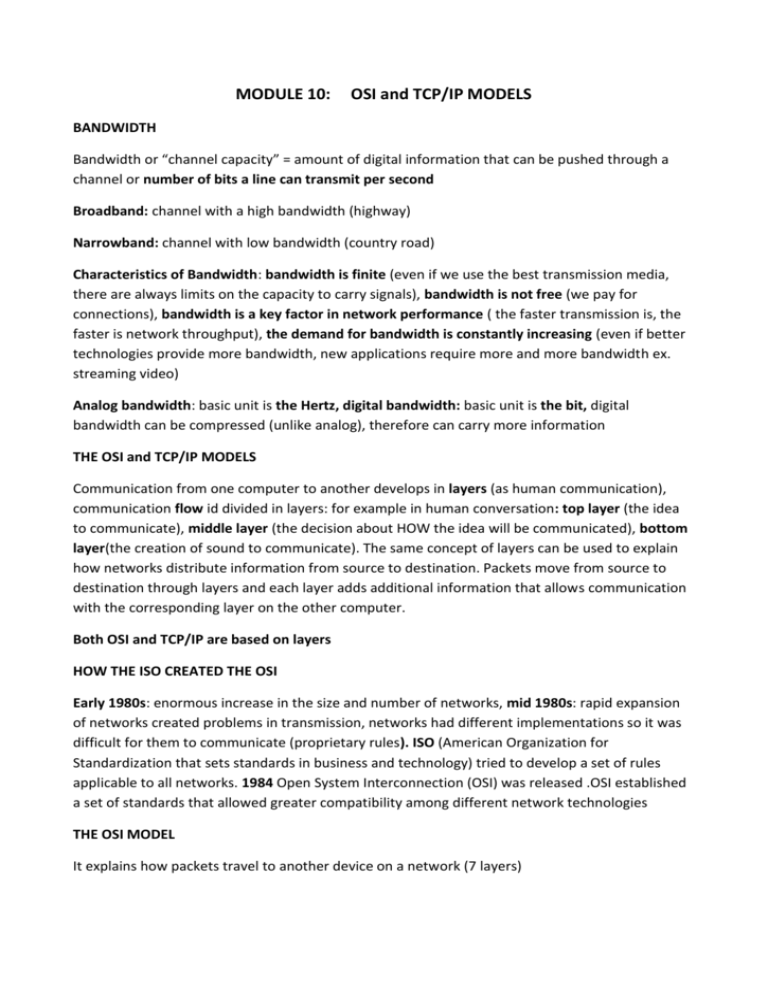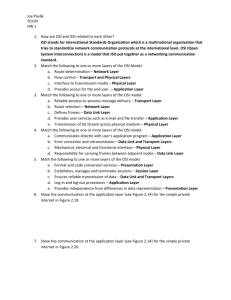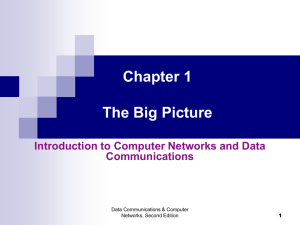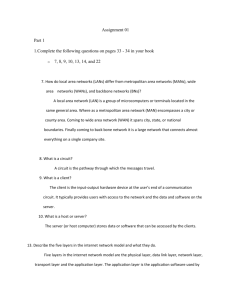SIMILARITIES TCP/IP and OSI
advertisement

MODULE 10: OSI and TCP/IP MODELS BANDWIDTH Bandwidth or “channel capacity” = amount of digital information that can be pushed through a channel or number of bits a line can transmit per second Broadband: channel with a high bandwidth (highway) Narrowband: channel with low bandwidth (country road) Characteristics of Bandwidth: bandwidth is finite (even if we use the best transmission media, there are always limits on the capacity to carry signals), bandwidth is not free (we pay for connections), bandwidth is a key factor in network performance ( the faster transmission is, the faster is network throughput), the demand for bandwidth is constantly increasing (even if better technologies provide more bandwidth, new applications require more and more bandwidth ex. streaming video) Analog bandwidth: basic unit is the Hertz, digital bandwidth: basic unit is the bit, digital bandwidth can be compressed (unlike analog), therefore can carry more information THE OSI and TCP/IP MODELS Communication from one computer to another develops in layers (as human communication), communication flow id divided in layers: for example in human conversation: top layer (the idea to communicate), middle layer (the decision about HOW the idea will be communicated), bottom layer(the creation of sound to communicate). The same concept of layers can be used to explain how networks distribute information from source to destination. Packets move from source to destination through layers and each layer adds additional information that allows communication with the corresponding layer on the other computer. Both OSI and TCP/IP are based on layers HOW THE ISO CREATED THE OSI Early 1980s: enormous increase in the size and number of networks, mid 1980s: rapid expansion of networks created problems in transmission, networks had different implementations so it was difficult for them to communicate (proprietary rules). ISO (American Organization for Standardization that sets standards in business and technology) tried to develop a set of rules applicable to all networks. 1984 Open System Interconnection (OSI) was released .OSI established a set of standards that allowed greater compatibility among different network technologies THE OSI MODEL It explains how packets travel to another device on a network (7 layers) ADVANTAGES: breaks network communication in smaller, more manageable parts; standardizes network components so different types of hardware and software can communicate, prevents changes in one layer from affecting other layers. UPPER LAYERS (7-6-5-4) APPLICATION LAYER (7): defines the language that programs use to communicate ( represents the purpose of communication ex. sending an e-mail message) PRESENTATION LAYER (6): negociates and manages the way data must be encoded SESSION LAYER (5): coordinates communication (services offered by this layer are sometimes incorporated into transport layer) TRANSPORT LAYER (4): responsible for validity and integrity of transmission (performs a check on data to ensure entire message is transmitted from sender to receiver) LOWER LAYERS (3-2-1) these layers are designed simply to move packets NETWORK LAYER (3): establishes the route between the sender and the receiver across switching points (routers) DATA LINK LAYER (2): responsible for node to node validity and integrity of transmission ( bits are divided in frames) PHYSICAL LAYER (1): receives and re-transmits bits, has no understanding of the meaning of the bits, deals simply with electrical signals PEER -TO -PEER COMMUNICATION -A form of communication used in the OSI model where each layer at the source communicates with the corresponding layer at the destination. -protocols of each layer exchange information called protocol data units (PDUs), each layer at source computer communicates with a layer-specific PDU and its peer layer on destination computer -each layer depends on the function of the layer below, the lower layer uses encapsulation to put PDU from upper layer into its data field as data moves down, the layers add additional information by means of headers and trailers. At layer 4 (TRANSPORT), the PDU is called SEGMENT , (it has encapsulated all the information provided by the previous layers). Then the NETWORK layer (3) moves data through the internetwork, to do this it encapsulates data , adds a header with information to complete the transfer and creates a PACKET. The DATA LINK layer also provides a service to the previous layer, it encapsulates the network layer information in a FRAME, the frame header contains information (ex. physical addresses), finally, the PHYSICAL layer provides a service to the data link layer, it encodes the data link frame into a pattern of 0s and 1s for transmission on the medium (usually a wire). THE TCP/IP MODEL -Created by US Department of Defense to provide a network that could survive in any condition including nuclear war -developed as an open standard so anyone could use it -4 layers, some layers have same name as OSI model APPLICATION layer (includes APPLICATION, PRESENTATION, SESSION of OSI model), deals with encoding information and dialog control TRANSPORT layer (same name in OSI), deals with flow control and error correction INTERNET layer (corresponds to Network layer in OSI), defines best path and packet switching NETWORK ACCESS layer (includes Physical and Data link of OSI), controls host-to –network communication) IP vs. TCP: IP points the way for the packets, TCP provides a reliable transport SIMILARITIES TCP/IP and OSI -both use layers -both have application, transport and network layers which are similar -both based on packet switching (packets take different routes to reach the same destination) DIFFERENCES TCP/IP-OSI -in TCP/IP APPLICATION layer includes PRESENTATION and SESSION of OSI -in TCP/IP NETWORK ACCESS layer includes PHYSICAL and DATA LINK of OSI -TCP/IP appears simpler because it has fewer layers








